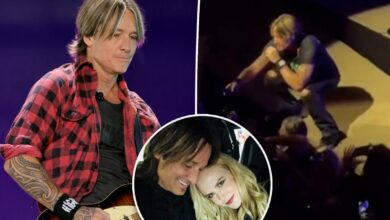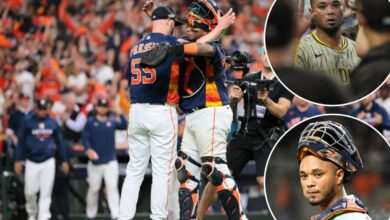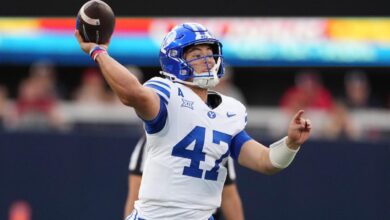NYPD agrees to steer clear of violent Brooklyn nabe — labeling the two-block stretch a ‘police free zone’

A notoriously violent two-block stretch of Brooklyn is fighting crime — by keeping uniformed cops away, The Post has learned.
NYPD officials agreed to turn a sliver of Brownsville in the NYPD’s 73rd Precinct into a “police free zone” last week as part of an city-funded experiment called the Brownsville Safety Alliance that initially was only twice a year but now runs four times annually.
And it’s an initiative that’s received praise from anti-cop, mayoral frontrunner Zohran Mamdani, an official with the group that runs it told The Post.
“He believes in what we do,” said Dushoun Almond, program director of Brownsville in Violence Out, adding that the socialist Queens assemblyman even stopped by when a zone was in operation last April.
Cops can still be called for serious crimes such as stabbings or shootings, but members of his community group replace them for low-level offenses from noon to 6 p.m. on Mother Gaston Boulevard between Sutter and Pitkin avenues from Oct. 7 through Oct. 11, people involved with the program said.
Not everyone inside the NYPD was impressed.
“It has the potential to go sideways quickly,” a police source said. “This is the way that this new guy [Mamdani] wants us to go. [The brass] are trying to appeal to him. It’s insane.”
The Brownsville Safety Alliance — which was first started in 2020 under former mayor and avowed Marxist Bill de Blasio — includes about 20 members of a community group who walk the two blocks and handle low-level calls that come into 911 during the hours its in operation, police sources said.
A plainclothes “BSA sergeant” — a member of the NYPD — is assigned to shadow the community members in case more serious issues arise. Police officers are also stationed on the edges of the two blocks, the sources said.
A flyer that appeared on X that was posted in the neighborhood said cops were forbidden from entering the zone.
“No on duty [uniformed members of service] are to enter this area unless responding to an extreme police emergency (e.g. person shot, stabbed, etc. ),” the flyer states. “This event is being monitored at the Police Commissioner level.”
The flyer was first reported by retired cop John Macari’s podcast.
The NYPD shot down the flyer. “That was an unauthorized sign that was posted, and the signs have been removed,” a department spokesperson said. “Nothing has changed about our operations or deployment there.”
But Almond, of Brownsville In Violence Out, said the organization takes the lead on BSA and handles low-level 911 calls while uniformed cops stay away.
“They’re not gone, but they give us our room to control the block,” Almond said of the police.
“There’s a BSA every three months,” Almond said.
Examples of calls his group handles include “a disturbance in a store” or “a situation on the block where guys are drinking,” he said.
“We use our credibility,” said Almond, who goes by the nickname “Bigga” and grew up in the area. “We try to alleviate the situation. There’s really no push back because they don’t want any problems.”
During the BSA, groups also set up tables where locals can get help with healthcare, housing, addiction and other issues, he said.
This month’s BSA was uneventful, he said. They group didn’t handle any calls. “It was good, it was quiet. We had a gas main leak, that was it. That’s real good news.”
BSA is an initiative of the massive Brooklyn-based non-profit social services group CAMBA, which has received more than $915 million in city contracts and funding since fiscal year 2020, records show. It was not immediately clear how much funding the BSA has received since its inception.
Most community members who spoke with The Post on Oct. 11 were pleased with the initiative — but didn’t think it could replace police.
A 57-year-old hardware store worker, who identified himself as Jose, said the BSA patrols “do a better job because they talk – ‘Yo, what’s going on?’ ‘What’s the problem?’ ‘Why are you doing this?’ . . . People listen.”
At the end of the day Saturday, a fight broke out among teenage boys with metal pipes and scooters in the designated area, he said. An NYPD vehicle from the 73 drove by with lights flashing as the group dispersed, he said.
Jamixa Alvarez, who works at Cricket Wireless on the stretch of Mother Gaston Boulevard, liked the idea of the community taking care of itself but doesn’t think it’s a permanent solution to the area’s crime problem.
“In 2025, being a cop isn’t the easiest job,” the 28-year-old said. “But right now we need our cops.”
The idea for the BSA was first hatched by former precinct Commander Inspector Terrell Anderson, who recently came under fire for a scandal involving the police academy.
Avenue. J.C. Rice
Anderson, who led the NYPD’s “Candidate Assessment Division,” was transferred to the housing unit in May as part of an Internal Affairs Bureau probe into claims he allowed more than 70 candidates stay at the academy despite failing psych requirements.
Several major crimes are up in Brownsville.
While murders and shootings dropped 83% and 40% respectively in the 73rd Precinct so far in 2025 compared to the same point last year, robbery is up 23%, from 191 to 234; felony assault is up 26%, from 521 to 654; burglary is up 40%, from 111 to 155; and grand larceny is up 30% from 284 to 368, data show.
“Historically, this is one of the most dangerous parts of NYC when we think about citywide shooting and homicide areas,” said former NYPD supervisor Christopher Hermann, now an assistant professor at Manhattan’s John Jay College of Criminal Justice.
“I am not sure how designating this as a police-free zone will help residents feel or actually be safer.”
In June 2024, two young girls, 9 and 11, were struck by stray bullets when they were caught in the crossfire as they played in Brownsville’s Hilltop Park less than a mile away from the zone.
Republican mayoral candidate Curtis Sliwa called the BSA program “a reckless experiment that invites chaos and puts residents and businesses at risk.”
“Community groups can and should partner with the NYPD, but sidelining cops in a high-crime area is exactly the backwards approach Zohran Mamdani is cheering on, and I’ll end it on Day One,” said Sliwa, who is also the founder of the criminal watchdog group Guardian Angels.
One long-time Bronx cop said anti-cop pols can reap what they sow.
“If this is what these politicians want, let them have it,” the cop said. “Let it burn down and then they’ll want us back.”
Credit to Nypost AND Peoples




